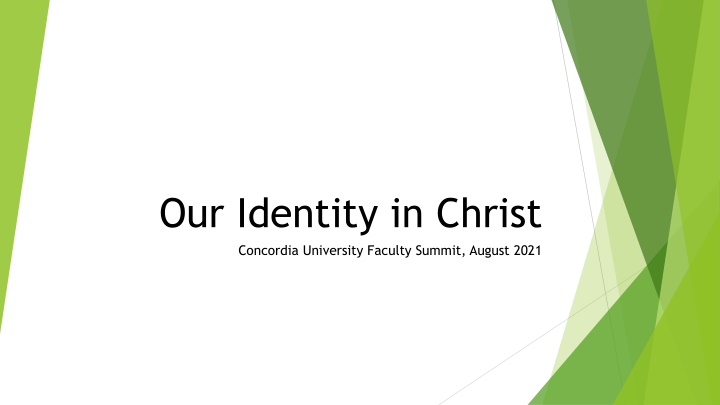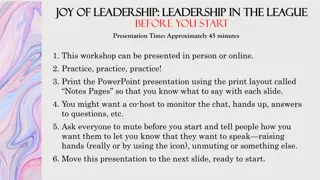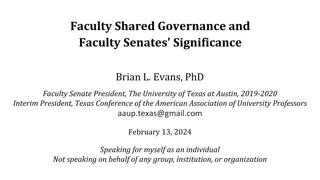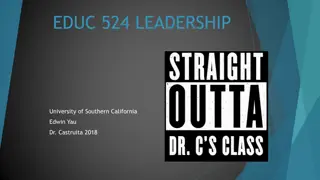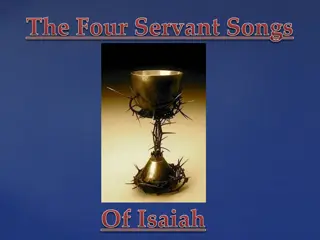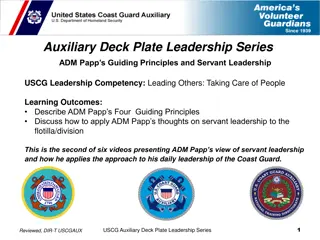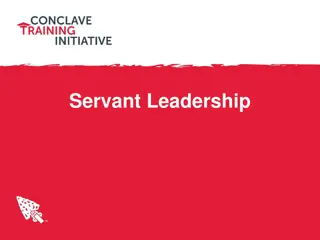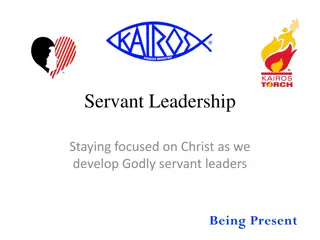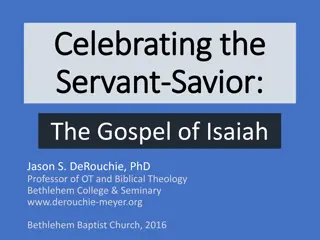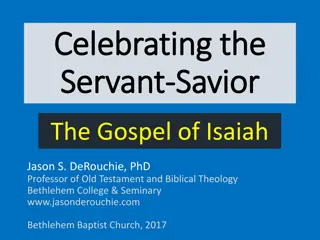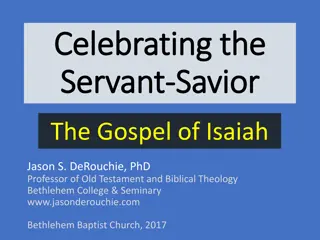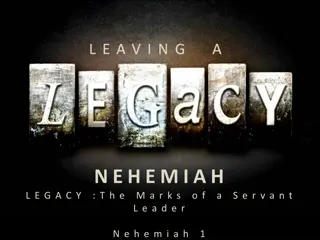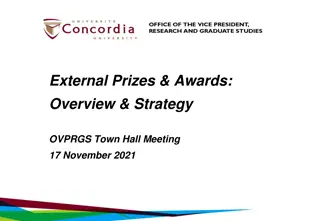Unveiling the Power of Servant Leadership at Concordia University Faculty Summit
Dive into the transformative potential of servant leadership as the defining principle at Concordia University's Faculty Summit. Discover how embracing servant-leadership can elevate the mission, foster meaningful relationships, and empower students to live lives of significance and purpose in mind, body, and spirit.
Download Presentation

Please find below an Image/Link to download the presentation.
The content on the website is provided AS IS for your information and personal use only. It may not be sold, licensed, or shared on other websites without obtaining consent from the author.If you encounter any issues during the download, it is possible that the publisher has removed the file from their server.
You are allowed to download the files provided on this website for personal or commercial use, subject to the condition that they are used lawfully. All files are the property of their respective owners.
The content on the website is provided AS IS for your information and personal use only. It may not be sold, licensed, or shared on other websites without obtaining consent from the author.
E N D
Presentation Transcript
Our Identity in Christ Concordia University Faculty Summit, August 2021
Assumptions GLO #2 (Service and Global Leadership) gets at the HEART of our mission! 1. CUWAA does well developing students in mind, body, and spirit, but can do better in our focus on service. 2. Live Uncommon may be a good marketing tag, but it lacks specificity and depth; therefore, it can t be used to define who we are. 3. The tenets of servant-leadership can be the organizing principle that defines CUWAA and lifts up the service dimension in our mission statement in meaningful and significant ways. Therefore, servant- leadership can make us uncommon! 4.
Preview What is servant-leadership? (Q & A) What would CUWAA look like if we were driven by servant- leadership principles? (Q & A) How can we foster servant-leadership among our students? (Q & A)
1. What is servant-leadership? It has been God s plan for us from the beginning: Ezekiel 34; Mark 10: 42-45; John 13:1-17; John 21:15-17; 1 Peter 5:1-3. Jesus leads the way: Matthew 20:25-28. God works IN and THRU us. Holy Spirit is the power. Word and Sacraments. And plenty of forgiveness!!! In 1970 Robert K. Greenleaf coined the term servant-leadership after reflecting upon his experiences in higher education (Wheeler, 2012). The hyphen is important. Defining servant-leadership is challenging, but I like these two: 1) a decision by any person to commit themselves to others in a way that subordinates personal gain to a wider sense of responsibility (General Stanley McChrystal) and 2) real leadership occurs when everyone else believes they are in charge (Bono). Servant-Leaders are motivated by a desire to help/serve others rather than by power, prestige, or money; this puts servant-leadership in sharp contrast to traditional, power-based leadership (Keith, 2008). Servant-Leaders place a premium on SERVICE, want each follower to live a life of significance and purpose, value the freedom and dignity of the individual, want followers to fully develop their gifts and abilities, and value wholeness and growth for their followers and themselves (Fryar, 2001).
So, servant-leadership is about building relationships by: *LISTENING to others, *CARING for others, *ENCOURAGING and AFFIRMING others, *EMPOWERING others, and *SERVING others. *All flowing from our faith in Jesus as Lord and Savior. It s a way of life!!! It s a worldview, not just a set of actions.
2. What would CUWAA look like if we were driven by servant-leadership principles? We are in a good starting place! Rev. Randy Duncan s observations . . . My observations . . . Our Strategic Plan is situated to promote servant-leadership: GLO #2, strategic imperative #3; spiritual vitality KPI, strategic stream #5. Our theology supports servant-leadership: vocation, servanthood, sacrifice, grace, redemption, love, theology of the cross vs. theology of glory. Indeed, THIS is what makes us uncommon in higher education!
A Vision for Our Future not a radical transformation but a sharper focus on our mission We teach servant-leadership to our students via: units within courses, entire courses, new student orientation, student leader training, etc. We offer dozens of designated service-learning courses. And we tie service and service- learning to vocation (Feenstra, 2011). (Dr. Rachel Pickett . . .) We run a service-themed living-learning community within our residence halls. We hold a robust Week of Service. We hold an annual Day of Service. We upgrade the Director of Faith Integration for Athletics and Director of Christian Service positions. And we create an Office for Service-Learning. We establish a food pantry (Allen and Alleman, 2019). We present an introduction to servant-leadership in Concordia Cares. We explore servant-leadership among faculty and staff throughout the year in various settings, always looking for ways to connect our faith with our service: WHY do we serve? Alumni engage with us.
So what would be different? 1. We would be DELIBERATELY and STRATEGICALLY preparing our students to be servant-leaders. 2. Our position leaders (faculty and staff) would be given tools to be even better leaders than they already are. 3. Our message to our community would be unmistakably clear: The Gospel of Jesus Christ moves us to serve you. 4. Our relationships with one another will be enhanced by our commitment to servanthood grounded in our Christian faith. 5. The percentage of employees who report being fully engaged in our mission/ministry would soar beyond 51%.
How do we get there? It begins with administrative buy-In. Our new president must be on board. Our strategic plan has to be tweaked. Resources have to be allocated. Faculty champions must step forward. Training must occur: Greenleaf Center for Servant Leadership (Seton Hall University), Spears Center for Servant Leadership (Indianapolis), and/or Viterbo University (LaCrosse) can provide us with online courses, resources, and speakers. For example, GCSL is currently offering a 3-month collaborative online course on Implementing Service Leadership for $425. Don Frick (2009) Implementing Servant Leadership Reach out to Tom Thibideau at Viterbo
3. How can we foster servant-leadership among our students? This is the litmus test! Model it. Teach it. Think about your discipline. Teachers as servants. Business persons as servants. Occupational therapists as servants. Social workers as servants. Psychologists as servants. Athletic trainers as servants. Pharmacists as servants. Pastors as servants. Etc. We must be INTENTIONAL about this!!!
Therefore . . . Our identity in Christ is this: We are forgiven sinners redeemed by Christ Jesus who calls each of us to BE servant-leaders and to FORM servant-leaders. This is what it means to Live Uncommon.
References Allen, C., & Alleman, N. (2019). A Private Struggle at a Private Institution: Effects of Student Hunger on Social and Academic Experiences. Journal of College Student Development, 60 (1): 52-69. Blanchard, K., & Broadwell, R. (Eds.). (2018). Servant Leadership in Action. Oakland, CA: Berrett-Koehler. Feenstra, J. (2011). Vocational Exploration through Service: The Effect of Service-Learning on Student Understanding of God s Calling. Journal Of Education & Christian Belief, 15:1, 65-74. Frick, D. (2009). Implementing Servant Leadership: Stories from the Field. Viterbo University (La Crosse, WI): D.B. Reinhart Institute for Ethics in Leadership. Fryar, J. (2001). Servant Leadership: Setting Leaders Free. St. Louis: CPH. Keith, K. (2008). The Case for Servant Leadership. The Green Servant Leadership. Kuh, G. (2008). High Impact Educational Practices. Washington, DC: AAC&U. Wheeler, D. (2012). Servant Leadership for Higher Education. San Francisco: Jossey-Bass.
